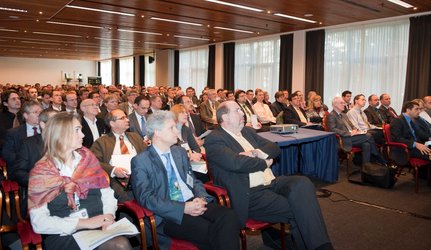About Meteosat Third Generation
The MTG series will comprise four imaging and two sounding satellites. The MTG-I imaging satellites will carry the Flexible Combined Imager (FCI) and the Lightning Imager. The MTG-S sounding satellites – a first for Meteosat – will carry an Infrared Sounder (IRS) and an Ultraviolet Visible Near-Infrared spectrometer, which will be provided by ESA as the Copernicus Sentinel-4 mission.
On the MTG-I satellites, FCI will scan the full Earth disc every 10 minutes using 16 spectral channels at very high spatial resolutions, from 2 km to 0.5 km. In ‘fast imagery mode’ it will be capable of a repeat cycle of 2.5 minutes over a quarter of the disc.
FCI will give increased support to nowcasting and very short-range forecasts (up to six hours) of high-impact weather such as thunderstorms or fog. It will also offer better capabilities for monitoring aerosols, making an important contribution to air-quality monitoring.
With its higher-resolution capability in the thermal–infrared, FCI will provide improved fire detection and an increase in the quality of various climate-relevant products.
The Lightning Imager will continuously monitor lightning activity in near-real time, supporting nowcasting of severe storms and warnings of lightning strikes, information that, in particular, will improve air navigation services close to airports and en route.
On the MTG-S satellites, IRS will provide detailed vertical profiles of atmospheric temperature and humidity at a high spatial resolution of 4 km. These data will feed into advanced regional Numerical Weather Prediction models expected to be used in the future for nowcasting and very short-range weather forecasting.
By monitoring atmospheric instability, the new sounder will also contribute to better early warnings of severe thunderstorms and is expected to provide unique information from geostationary orbit on ozone, carbon monoxide and volcanic ash composition within the atmosphere.
The primary objective of the Copernicus Sentinel-4 mission will be to support air-quality monitoring and forecasting over Europe, in full synergy with the IRS sounder.
About the European Space Agency
The European Space Agency (ESA) is Europe’s gateway to space.
ESA is an intergovernmental organisation, created in 1975, with the mission to shape the development of Europe’s space capability and ensure that investment in space delivers benefits to the citizens of Europe and the world.
ESA has 20 Member States: Austria, Belgium, the Czech Republic, Denmark, Finland, France, Germany, Greece, Ireland, Italy, Luxembourg, the Netherlands, Norway, Poland, Portugal, Romania, Spain, Sweden, Switzerland and the United Kingdom, of whom 18 are Member States of the EU.
ESA has Cooperation Agreements with nine other Member States of the EU and is negotiating an Agreement with the one remaining (Bulgaria). Canada takes part in some ESA programmes under a Cooperation Agreement.
By coordinating the financial and intellectual resources of its members, ESA can undertake programmes and activities far beyond the scope of any single European country.
ESA develops the launchers, spacecraft and ground facilities needed to keep Europe at the forefront of global space activities.
Today, it launches satellites for Earth observation, navigation, telecommunications and astronomy, sends probes to the far reaches of the Solar System and cooperates in the human exploration of space.
Learn more at www.esa.int
For further information, please contact:
ESA Media Relations Office
Communication Department
Tel: +33 1 53 69 72 99
Fax: +33 1 53 69 76 90
Email: media@esa.int
About Eumetsat
The European Organisation for the Exploitation of Meteorological Satellites is an intergovernmental organisation based in Darmstadt, Germany, currently with 26 Member States (Austria, Belgium, Croatia, Czech Republic, Denmark, Finland, France, Germany, Greece, Hungary, Ireland, Italy, Latvia, Luxembourg, the Netherlands, Norway, Poland, Portugal, Romania, Slovakia, Slovenia, Spain, Sweden, Switzerland, Turkey and the United Kingdom) and five Cooperating States (Bulgaria, Estonia, Iceland, Lithuania and Serbia).
Eumetsat operates the Meteosat-8 and -9 geostationary satellites over Europe and Africa, and Meteosat-7 over the Indian Ocean. The third Meteosat Second Generation satellite, MSG-3, was launched on 5 July 2012 and renamed Meteosat-10 after commissioning was complete.
Metop-A, the first European polar-orbiting meteorological satellite, was launched in October 2006 and has been delivering operational data since 15 May 2007. MetOp-B, the second satellite in the series, was launched on 17 September 2012, and MetOp-C, the third and final satellite in the series, is scheduled to lift off in 2018.
The Jason-2 ocean altimetry satellite, launched on 20 June 2008, added monitoring of sea state, ocean currents and sea-level change to the missions that Eumetsat conducts.
The data and products from Eumetsat’s satellites are vital to weather forecasting and make a significant contribution to the monitoring of environment and the global climate.
Media Relations Eumetsat:
Tel: +49 6151 807 7320
Fax: +49 6151 807 7321
Email: press@eumetsat.int
www.eumetsat.int















 Germany
Germany
 Austria
Austria
 Belgium
Belgium
 Denmark
Denmark
 Spain
Spain
 Estonia
Estonia
 Finland
Finland
 France
France
 Greece
Greece
 Hungary
Hungary
 Ireland
Ireland
 Italy
Italy
 Luxembourg
Luxembourg
 Norway
Norway
 The Netherlands
The Netherlands
 Poland
Poland
 Portugal
Portugal
 Czechia
Czechia
 Romania
Romania
 United Kingdom
United Kingdom
 Slovenia
Slovenia
 Sweden
Sweden
 Switzerland
Switzerland
































